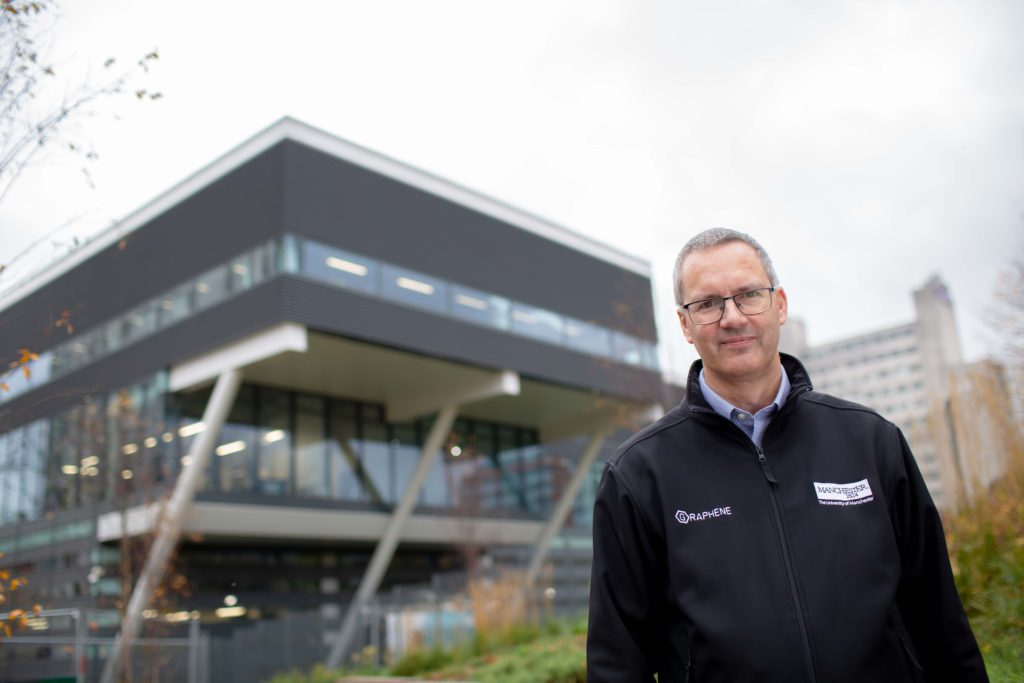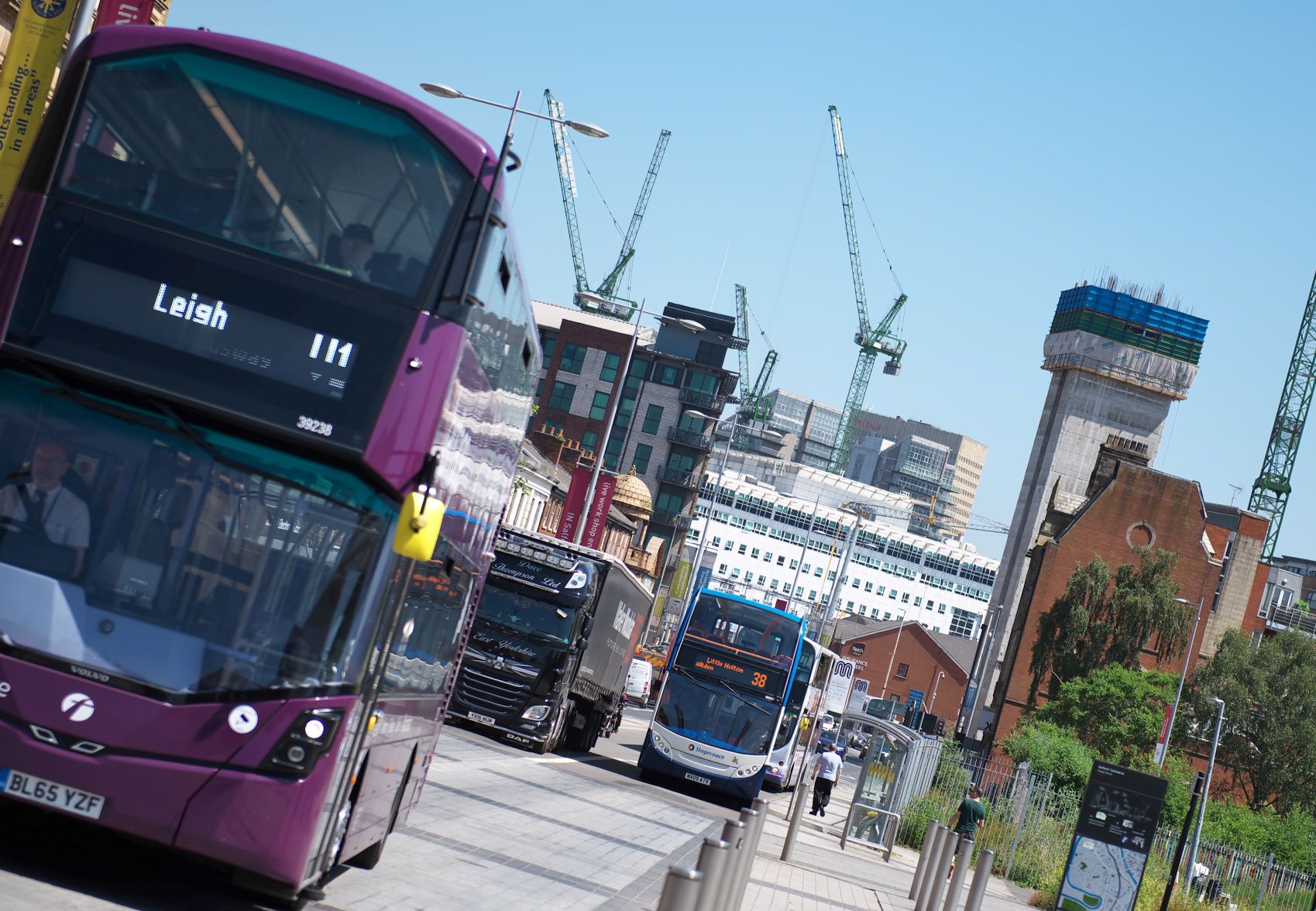Insights
Video: See inside the Manchester laboratories transforming 2D materials research into practical applications
The Graphene Engineering Innovation Centre (GEIC) is part of the investment in advanced materials in Manchester by GM LEP and is based in the Masdar Building at The University of Manchester. It specialises in the rapid development and commercialisation of products using graphene and other 2D materials.
Part of a significant investment to unlock the potential for advanced materials in Greater Manchester, the £60m Graphene Engineering Innovation Centre was launched in 2018.
The GEIC’s world–class facilities and resources are supported by experienced and knowledgeable applications engineers and internationally renowned academics, working across a broad range of novel technologies and applications. Together, they can help industrial partners design, develop, scale and ‘de-risk’ the next generation of innovative products and processes.
James Baker, CEO of Graphene@Manchester, said:
“Graphene is moving incredibly quickly; it is only 16 years young and we’ve seen the first products and applications hitting the marketplace. And it’s now not just a few niche products, we’re seeing some large manufacturers using graphene in their products or their applications to create real competitive advantage and benefit. So, my message to people is to engage, to talk to the team and to see how we might support you in your products and applications, where graphene can make a real productivity and performance advantage to your business.”
This video provides an opportunity to take a look inside the GEIC and hear from the partners, application specialists and Graphene@Manchester CEO James Baker on how the GEIC is helping businesses to turn ideas into products.

The Graphene Engineering Innovation Centre

James Baker, Chief Executive of Graphene@Manchester
Connectivity will be key to supporting GM’s post-Covid economic recovery
Lou Cordwell, Chair of the Greater Manchester Local Enterprise Partnership (GM LEP), says improving transport, including our bus network, will be crucial if the city-region is to support sustainable economic growth.
The third national lockdown has been, and continues to be, a hammer blow for businesses and people in Greater Manchester, but as the Government’s vaccination roll-out gathers pace we need to start turning our attention to the future as well.
In November, we launched a bold new vision for a greener and fairer Greater Manchester, ‘Building a Greater Manchester, Making a Greater Britain’, which provides a blueprint for remodelling the city-region’s economy. One of the key pillars to support this work is creating places where people want to live, work and invest.
A golden thread that links these three things together is connectivity. Back in 2019, the Mayor launched Our Network, Greater Manchester’s vision for an integrated and sustainable transport network that supports the city-region to be one of the best places to grow up, get on and grow old.
Making Our Network a reality will be vital if we are to support economic and population growth, especially as sustainable growth will both need, and be driven by, improved connectivity. This is true on both a local and pan-northern level, with Greater Manchester playing a crucial role in national efforts to level up and rebalance the UK economy.
To deliver the 2040 Transport Strategy, the aim is for 50% of all journeys in the city-region to be made by foot, bike or public transport – including buses – by 2040. That’s a million more sustainable journeys every day. For this to be realised, sustainable transport must become the first choice because it is easier, cheaper, or faster than non-sustainable modes. Bus travel will have a key role to play in achieving this ambition.
Pre-Covid, bus use accounted for 75% of public journeys – around 190 million journeys – and during the pandemic buses have remained vital to connecting communities with jobs, essential services and leisure, particularly for the one third of Greater Manchester households without access to a car.
However, even before the pandemic, the bus market in our city-region was in decline. Without intervention, the Greater Manchester Combined Authority (GMCA) expects that decline to continue.
Greater Manchester’s bus market is currently deregulated, meaning routes, services and fares are set by operators. There is limited competition in deregulated bus markets and in Greater Manchester this has meant that benefits such as value for money and innovation have not been seen. There is no guiding mind to plan our transport network overall based on our social and economic needs.
In the current market, the public sector spends a lot on bus services in Greater Manchester. For example, over £250m of capital expenditure has been spent on infrastructure projects since 2014 such as bus priority measures, stations and interchanges, along with over £100m from local and central government funding each year covering subsidised services, concessionary fares and fuel duty rebates.
With the disruption of Covid-19, the bus sector has been further supported with extra emergency funding to operators from government totalling £33.6m between March and September 2020. It is also likely that additional public funding will need to continue for some time.
The GMCA is seeking better outcomes for its investment. Last year the GMCA asked what should be done with our buses as part of the Doing Buses Differently consultation. Over 8,500 people responded, with four out of five supporting the proposed franchising scheme.
Under franchising proposals, the GMCA would co-ordinate and invest in the bus network based on passenger’s needs, with bus operators contracted to run the services. The GMCA would be responsible for the bus network which means it would also have more of the financial responsibility and the risks. However, the economic assessment of the Proposed Franchising Scheme concludes that it would provide the best value for money by offering a ‘high’ benefit to cost ratio and the greatest net economic value.
Covid-19 has caused a lot of uncertainty over how people will travel in future. Therefore, an additional consultation is underway to gather views before Friday 29 January on the impact of Covid-19 on the bus market and Greater Manchester’s proposals for reform. It’s important that the voice of business is heard in this consultation.
Greater Manchester forms one of the world’s most renowned areas for hospitality, culture, sport and arts and is the North’s leading business, retail and education centre – it requires a transport system befitting a leading city-region.
Beyond the pandemic, we’re determined to deliver on our Economic Vision and to seize the opportunity to remodel our economy. Improving transport for all in the city-region is a fundamental part of that. Our ambitions for green growth need to be supported by an integrated transport system and buses are a critical driver for connecting Greater Manchester’s people and places.

Local Energy Market boosts GM LEP’s green growth ambitions
Green growth is a priority within the Economic Vision for Greater Manchester. The pioneering creation of a Local Energy Market for the region is evidence of the innovation already taking place to achieve carbon neutrality by 2038.
Climate change is happening at an unprecedented rate, with sea levels rising, more carbon in the atmosphere than at any time in human history, and the warmest year on record in 2019. As a result, the environment is becoming a hot topic on the global agenda.
Whilst those facts seem scary, change is on the horizon as people and governments are beginning to wake up to the reality of climate change. Regions like Greater Manchester have already set in motion the plans to become a leading city-region in the global fightback against carbon emissions, pledging to get the region greener before it is too late.
Declaring a climate emergency in 2019, the city of Manchester, alongside the region of Greater Manchester, pledged to become a carbon neutral area by 2038, aiming to achieve the goal twelve years ahead of the UK government’s own national target of 2050.
The region is hoping to deliver a 13% reduction in carbon emissions every year leading up to 2038, and while it is an ambitious goal, it is achievable through innovation from individuals and businesses with progression in technological advancement, behavioural change and the use of Mancunian creative thinking.
A plan for a Local Energy Market (LEM) in Greater Manchester offers an example of how the private and public sector can work together to innovate in the fight against climate change. LEM plans to revolutionise the energy networks across the city-region, supporting a lower carbon future and to drive the region towards its 2038 goal of carbon neutrality. The project will also improve our city-region’s economic and environmental resilience, putting in place the energy infrastructure and grid capacity to support the use of lower-carbon energies.
Proposals would see the ten boroughs of Greater Manchester draw up plans to improve energy efficiency, upgrading energy infrastructure and introducing more electric vehicle charging points as the UK moves towards all road vehicles becoming electric, with the sale of new petrol and diesel cars being banned in just ten years’ time.
The LEM project reduces the overall environmental footprint of Greater Manchester, by building networks allowing energy to travel a much shorter distance from where it is first generated. The two-year project is already underway, running until June 2022, and is financed by a £3m grant from UK Research & Innovation, with partners including GMCA, which works with GM LEP to drive economic strategy for the region.
The pioneering LEM project will create a more efficient and cost-effective energy market for residents and businesses, focussing on the creation of hydrogen and heat networks to reduce carbon emissions and increase network capacity.
Cllr Andrew Western, GMCA Lead for the Green City-Region, said:
“This is a genuinely innovative project to be pioneering here in Greater Manchester, and one that will be a key element of our carbon-neutral ambitions by 2038.
“We know that we need to not only reduce but also optimise our energy consumption. A localised system can be a more efficient and cost-effective one for residents and businesses, allowing us to make the transition to new hydrogen and heat networks and increase the capacity of our electricity network.
“This is the smart way forward, and working together with our partners we can lay the groundwork for a low carbon future.”
Projects like the LEM could potentially provide additional economic advantages for Greater Manchester, creating thousands of new jobs associated with the new energy networks, as well as wider green sector jobs such as such as retrofitting homes for energy efficiency and constructing cycle lanes. This means that there is an opportunity to support the local economy whilst addressing key concerns around climate change.
The recently launched Economic Vision for Greater Manchester underpins the importance of green growth, with the Coronavirus pandemic having taught us the importance of protecting green spaces as a means to supporting the health and wellbeing of local people. As a leader in low carbon innovation, Greater Manchester can help drive the UK at the forefront of new clean technologies of the future.
The GM Economic Vision recognises the opportunity to reset the economy following Covid-19, whilst tackling inequality and supporting businesses to understand the importance of protecting both people and planet as good for productivity and profitability.
Chris Oglesby, GM LEP board member for green growth, said:
“Greater Manchester has the ability to drive the UK as a global leader in carbon innovation, and a Local Energy Market is key in the success of the region reaching carbon neutrality by 2038. Projects like this hold the key to solving the climate crisis, whilst creating the next generation of green jobs and infrastructure to support our economy and planet.
“The Covid-19 pandemic has presented us with an opportunity to reset capitalism. Green growth is at the heart of our GM Economic Vision, which sets out the blueprint for a modern economy driven by business and based on the understanding that looking after people and the planet is good for profitability and productivity.”
Find out more about green growth and the Greater Manchester Economic Vision.

Digital response to COVID-19 proves Greater Manchester’s capabilities in delivering health and social care innovation
Health and social care innovation is one of the priority sectors underpinning the Greater Manchester Economic Vision launched by GM LEP and sits at the heart of the Greater Manchester Industrial Strategy.
Pretty much overnight, the COVID-19 pandemic made it clear that digital health provision would be more important than ever before in supporting the needs of people who would find it more difficult to access physical appointments.
NHS Trusts paused some routine and non-urgent hospital care. Patients were asked only to visit their GP if necessary.
Alongside supporting routine care, attention also turned to the role for digital health and social care innovation in challenging the progress of the virus itself.
In Greater Manchester, the pandemic presented a unique opportunity to capitalise on the benefits of a £6.6bn devolved health and social care ecosystem, with organisations across the NHS, public and private sector, and universities already working in partnership.
When the pandemic first struck, one of the most significant achievements was a rapid acceleration in use of the Greater Manchester Care Record. Although it has been in existence for several years, the pandemic rapidly increased its use and the data flows going into it.
The GM Care Record collates information held by different health and care organisations to ensure that GPs, doctors, nurses and practitioners can see up to date medical records, care plans, medications and test results. It now informs the right care and treatment for almost all 2.8m people across Greater Manchester.
Under normal circumstances, the GM Care Record means that patients don’t have to repeat their medical history to each professional, that clinicians will be better equipped to identify patterns, and care will be planned more effectively to meet patients’ needs.
It builds on existing borough-based care records to create a single joined-up care record for all of GM. The system has been developed by tech company Graphnet, which specialises in developing health and care IT solutions.
In response to the pandemic, the GM Care Record now also includes information about when a patient has been tested or diagnosed with COVID-19, ensuring continuity of care across different care settings. For direct care purposes, the number of unique users using the record has grown from 4,599 (April 2020) to 9,451 monthly users (December 2020). 3.1m patient records from 443 GP practices are live on the system and more than 4,000 patient records are now being accessed each day.
The GM Care Record also provides the mechanism that will support other digital projects such as being able to monitor COVID-19 patients’ oxygen levels remotely, digitising heart failure care plans and monitoring pregnant women’s blood pressure from home for signs of preeclampsia.
The project was overseen by Health Innovation Manchester and the GM Health and Social Care Partnership, working on behalf of GM’s devolved health and care partners.
Rapid progress was made as part of the city region’s COVID-19 digital response plan and collaborative effort.
The GM Care Record is not just about care and treatment. It also provides the mechanism by which citizens’ deidentified health and care data related to COVID-19 can be used for research and secondary use purposes.
Greater Manchester has been disproportionately affected by COVID-19. Likewise, there are communities within GM that have been disproportionately affected.
The use of deidentified patient data for research enables healthcare professionals to understand this and inform GM’s health and care response to the pandemic and ultimately to care.
Potential secondary uses include work to understand COVID-19 trends and risks to public health and controlling and preventing the spread of COVID-19.
Sir Richard Leese, chair of the Greater Manchester Health and Social Care Partnership and a GM LEP board member, said:
“Greater Manchester has a proud history of embracing innovation and has long been a crucible of new ideas and pioneering research.
“Our unique devolution agreement has given us the freedom to explore and invest in the benefits new technology can bring, allowing us to better share data between organisations, to increase access to services and ultimately improve the lives and health of local people.
“Plans were already underway to use new digital tools within our health care system before the outbreak of coronavirus. However, the demands created by the pandemic have seen them introduced at a pace previously unimaginable. We are now seeing more people than ever before consulting with doctors remotely, more people being able to access mental health support from home and the development of the Greater Manchester Care Record supporting more health and care workers to do what they do best, caring for people.”
Digital health innovation underpins the Greater Manchester health and social care landscape, exploring new means of improving health and access to health. Utilising data sharing with appropriate permissions and governance can improve health outcomes not only here, but across the world.
Health and social care innovation supports inward investment too, with national and international organisations keen to become part of a dynamic health ecosystem. Launched in January 2021, the Christabel Pankhurst Institute for Health Technology is just one example.
Delivered by a consortium led by the University of Manchester, it is supported with a £5m investment from the Local growth Fund managed by GM LEP and Greater Manchester Combined Authority, with further backing from the NHS, Health Innovation Manchester and Manchester University NHS Foundation Trust.
Building on the university’s research strengths in digital technology and advanced materials – another priority sector in Greater Manchester – the institute will develop innovative solutions to pressing health and care challenges, fostering new collaborations, improving lives and catalysing growth in the health innovation business sector.
Published pre-pandemic in June 2019, the Greater Manchester Local Industrial Strategy underlines Greater Manchester’s ambition to be a global leader on health and social care innovation, not only creating new industries and jobs, but also improving population health and extending healthy life expectancy.
Launched in November 2020, the GM Economic Vision built on the LIS, with initiatives including Innovation GM, a new platform which will bring together Greater Manchester’s public and private sectors, educational institutions and specialist facilities to attract research and development funding and drive economic growth.
This will be targeted at frontier sectors identified by the LIS: health, digital, clean technologies and advanced manufacturing and materials.
Another key theme within the Economic Vision is addressing the inequalities known to lead to poor health. Again, digital innovation has a part to play.
Lou Cordwell, Co-Chair of GM LEP, said:
“Covid has shown the vital link between health and productivity; building on health devolution, Greater Manchester can use its assets to be at the forefront of global health innovations and new models of care.”
Professor Ben Bridgewater, Chief Executive of Health Innovation Manchester, added:
“Even before COVID-19 hit, we had increasingly been viewing digital as important to pretty much all of the innovation work that we were doing in Health Innovation Manchester.
“We began to view it holistically and saw that there were very few programmes of work within the organisation that couldn’t be more transformational or delivered more efficiently if they embraced digital.
“I think when a lot of people talk about digital, they talk about the potential benefits of data or artificial intelligence.”
“But our definition of digital transformation within healthcare is the way in which technology is transforming the products and services that are provided to citizens for the diagnosis and treatment of disease and the maintenance of wellness.”
The GM Economic Vision reveals how Greater Manchester can influence a healthier UK.
It sets out a commitment for Greater Manchester to be recognised around the world for our global strengths and progressive thinking in advanced materials and manufacturing, health innovation, digital and creative, and clean growth.
Click here to find out more about the GM Economic Vision.
Digital health and social care innovation has been accelerated by COVID-19, with initiatives in Greater Manchester including:
- Development of the Greater Manchester Digital Platform: Greater Manchester’s councils, NHS organisations and other public bodies are working together to invest in new technologies and to explore better ways of working to join up data from the many systems across the public sector. This will allow data to be used more effectively to enhance care and improve services. The GM Care Record, which has been a long-term co-investment by Clinical Commissioning Group’s in the city region, is a fundamental component in this and now covers >99% of the GM population, with Covid accelerating its adoption. It is now being accessed approximately 9,000 times per week by staff across Greater Manchester. The GM Digital Platform is a newer, parallel programme focussed more on connecting data across public services to drive improvements in the health and wealth of Greater Manchester’s 2.8m citizens. The Digital Platform is a re-usable set of infrastructures that can be rapidly adopted in other priority areas to drive improvements. Partners in Greater Manchester are exploring how The Digital Platform can be applied within victim support, tackling homelessness and improving support for vulnerable families.
- Examples of digital apps utilising the tech in the Greater Manchester Digital Platform include The Early Years App and The Community Hub App. The Early Years App is a UK first for Digital Health Visiting and is due to go live in early education shortly as well. Taking away the need for paper forms and speeding up support, over 1,600 families have been engaged with the App so far since go live in September, giving parents and carers the ability to fill in forms digitally and have access records for the first time alongside digital recording professionals. The new system will also help health visitors to identify developmental issues earlier and provide support for the child and their families quicker than current methods. The Community Hub Application was launched during the COVID-19 pandemic to match volunteers with vulnerable people in need of support across the city-region.
Mental Health Support: Thousands of people across Greater Manchester are being supported by new digital and online services as part of city-region response to mental health during COVID-19. Services rolled out across GM include: SHOUT, a confidential 24/7 text service operated by trained crisis volunteers; Kooth – an online counselling and emotional wellbeing platform for children and young people; and SilverCloud – an online therapy programme for adults proven to help with stress, anxiety, low-mood and depression.
Social Care support: Health Innovation Manchester has worked with social care partners with an aim to provide care homes with greater access to technology, tools and patient information so that they are better equipped to protect and care for vulnerable residents in the event of a COVID-19 outbreak.
Health and care professionals from Greater Manchester worked with tech company Safe Steps to develop a UK-first digital innovation that will help care homes to track COVID-19 and coordinate care with GP practices, social care and hospitals to optimally support vulnerable residents.
The tool allows care home staff to input information about a residents’ COVID-19 related symptoms into a tracker, which can be shared directly with the resident’s GP and NHS community response team to ensure that a swift assessment and response can be put in place. Following a successful rollout in Tameside and Glossop in April 2020, the COVID-19 tracker is now in use in 101 care homes across seven localities in Greater Manchester. In total it means more than 3,100 residents are being supported through the tracker, with over 240,000 assessments taking place since April 2020
Primary Care Support: A digital primary care support package using the skills, expertise and resources from Greater Manchester Health and Social Care Partnership, Health Innovation Manchester and GM Shared Services has been created to support rapid deployment of new solutions and transformational changes taking place.
PPE stock level monitoring: Launched in June 2020, a new, first of its kind, situation reporting system is being used to monitor PPE stock levels, staffing availability, infection rates and outbreaks. It allows all ten Greater Manchester councils to share data in one place, creating a visual dashboard to show a clear picture of operational pressures during COVID-19.

COVID catalyst: how graphene can lead the ‘green’ recovery
James Baker, CEO of Graphene@Manchester, says innovation in advanced materials has the potential to support social, economic and technological opportunities to help achieve a green recovery following the impact of COVID-19. Supported by GM LEP and a priority within the GM Economic Vision, Greater Manchester is a leading centre for advanced materials research.
Innovation in advanced materials offers the disruptive potential to transform the way we build our future cities, as well as the transport and infrastructure systems that connect them.
Alongside its health impact, the COVID-19 pandemic has upturned the global economy, with the International Monetary Fund estimating it could cost as much as US$28 trillion in lost output. So governments around the world are being urged to use this disruptive period as a catalyst and align their recovery efforts with sustainable development initiatives.
In fact, the International Renewable Energy Agency (IRENA) has estimated that if we doubled annual global energy transition investments to US$2 trillion over the next three years it would boost global GDP by 1% (roughly $300-400 billion). I am convinced that some of this investment should be put into innovation around advanced materials so we can literally build back better – at the same time we can look to take up global opportunities and work with our international partners, just as Graphene@Manchester is working with Masdar.
With COVID-19 now acting as a catalyst, a number of partners at the Graphene Engineering Innovation Centre, the flagship graphene innovation accelerator based at The University of Manchester, are already conducting exciting experiments in applying graphene to concrete and road surfaces to create composites with greatly improved performance capabilities and, as result, reducing their respective carbon footprints throughout the supply chain.
This will be of great interest to the Middle East and Africa, where ambitious capital investments continue to drive the construction and infrastructure sectors. The use of graphene in concrete, for example, can make this building material stronger, more water-resistant and eco-friendly – and it is estimated that around 60 million tonnes of carbon dioxide a year could be saved by using graphene-enhanced concrete in these regions.
Another graphene application that could have a huge impact is the development of advanced water filtration and much more efficient and effective desalination systems. This improved type of membrane infrastructure could supply the fresh water that is much needed by urban communities already feeling the impact of global warming.
The idea of improving the sustainability of materials for buildings and infrastructure is clearly going to be a potential game-changer – but another very interesting area is how we can use the benefits of advanced materials to support cities to become even smarter.
So-called ‘smart cities’ are seen as a way to make our urban environments much more efficient and greener through the adoption of digital technologies that can, for example, better integrate and manage our utility and energy systems.
However, what if some of this technology was embedded directly into the materials that went into our buildings and infrastructure? The exciting thing about graphene and the wider family of 2D materials – the endless combination of ultra-thin layers to develop brand new ‘designer materials’ that collectively I call the ‘graphenes’ – is their extraordinary multifunctional capability. Such materials would be ideal to develop a new generation of smart infrastructure.
As an example, the GEIC is currently working on a number of projects with Highways England, the government company responsible for much of the nation’s major road network, and Arcadis, a leading global design and consultancy firm for natural and built assets.
We are supporting these partners in addressing the challenges around construction and the road network. An example might be when electric circuitry needs to be applied to the network and could be laid at the same time as the highway, for example, as an integral part of the structure.
This is still an early-stage project and will require a lot of new thinking – the solution could be within the bitumen or a surface marker, such as the road line. But what if we could have this multifunctional capability used across all the infrastructure and buildings that make up a town or city? It would transform connectivity and make the very fabric of our built environments responsive and intuitive to our daily needs.
So, we can start to imagine charging points that are embedded across our road network – and every time an electric car comes to a stop at traffic lights or rests in a parking space it can be charged in situ. If the vehicles of the future were using hybrid energy storage – ie a battery powertrain with a graphene-enhanced supercapacitor unit – then they could be rapidly charged as their drivers happily go about town. And those batteries and supercapacitors would, of course, feature new materials that enable them to operate far more effectively compared to the energy storage devices we are obliged to use today.
Similar advances could be made with sensor technology, which will also be highly critical if cities are to achieve the required connectivity levels needed to become smarter, more efficient and ultimately greener.
Graphene and advanced materials therefore have a huge role to play in building a better and greener future. With the call for new investment in green technology, I believe we should be thinking of advanced materials as among the most important underpinning technologies to revitalise our battered economies and, ultimately, deliver better, more sustainably future-proofed lives for us all.
Find out more about Graphene@Manchester here.

Advanced materials research in Manchester is supporting Highways England projects

James Baker, Chief Executive of Graphene@Manchester
Digital Security Innovation Hub set to launch following GM LEP investment
Home to the nation’s fastest-growing cyber ecosystem, a Top 20 European Digital City, and now a base for GCHQ, Greater Manchester is at the forefront of cybersecurity and innovation. The region is now building on its heritage in scientific advancements with a new £10m Digital Security Innovation Hub supported by GM LEP.
As the birthplace of the industrial revolution, home to ‘Baby’, the world’s first stored programme computer, and Alan Turing, pioneering computer scientist and war hero – Manchester has a proud history of innovation in science.
From the days of huge computing machines stored at The University of Manchester to the small slimline devices we own today, the city continues to lead the way in cyber and is experiencing a boom in cybersecurity businesses drawn to the region by its cyber expertise and heritage.
With the world becoming increasingly digital, so does the growing threat of cybercriminals and hackers looking to take advantage of weaknesses online. But Manchester is fighting back, and the city is now set to play a major part in the cracking down on cybercrime, with a new base for Government Communications Headquarters (GCHQ) already in the city.
Opened in 2019, the UK government selected Manchester as home to its new GCHQ base, recognising the city’s position as a leading European digital city, with a cluster of technical expertise on hand for innovation and research. GCHQ’s Manchester office will be key to improving cybersecurity and preventing terrorism and is creating hundreds of jobs.
Set to open in early 2021, a new Manchester Digital Security Innovation Hub will be set up within GCHQ to bring together companies, universities and the government, providing collaborative space for the sharing of ideas and best practice, placing the city at the forefront of responding to digital threats.
Drawing on expertise from the four major universities across the region, and a talent pool of over 86,000 people who work in the creative, digital and tech sector, the Digital Security Innovation Hub will work with everyone from small start-ups to large corporations.
The hub is being set up thanks to £5m of funding from GM LEP and Greater Manchester Combined Authority via the Local Growth Fund.
Sir Richard Leese, leader of Manchester City Council and GM LEP board member, said:
“This is an exciting project which will help stimulate economic growth and create jobs in this fast-growing sector which is emerging as one of Manchester’s distinctive strengths.”
“Such initiatives are more important than ever as we begin to recover from the Covid-19 pandemic and look to the future.
“As the world continues to face cybersecurity challenges, the digital security innovation hub will place Manchester in the forefront of driving creative solutions and responses and help make this a trusted place to do business.”
Greater Manchester continues to build on its reputation as one of the world’s best cities for digital technology and cybersecurity. The new Digital Security Innovation Hub will serve as a leading centre of research and innovation for cybersecurity, taking advantage of the expertise and talent on offer across Greater Manchester.
The hub, alongside major projects like GCHQ’s move to Manchester, are not only important for the national effort to fight cybercriminals, but also attract huge levels of investment from digital companies, creating more than 86,000 jobs and cementing the city as a world-leading cyber super hub.
As second in the world at attracting talent from London (with only New York attracting more), the new Digital Security Innovation Hub will foster the next generation of cyber professionals.
Through the hub, new start-ups will find space to grow, whilst existing cyber businesses will be able to collaborate and access support on the commercialisation of new products and services.
The Manchester Digital Security Innovation Hub joins a city which is also home to the Cyber Resilience Centre, a joint venture between Greater Manchester Police and Manchester Digital, and the Greater Manchester Cyber Foundry, a partnership of four North West universities that helps small to medium sized businesses prepare for the digital future.
Named in the 2020 Tech Nation Report as the fastest-growing major tech cluster in Europe, Manchester’s digital, creative and technology sector contributes around £5 billion to the region’s economy, with around 10,000 businesses including major investors such as Amazon, BAE Systems, and booking.com.

